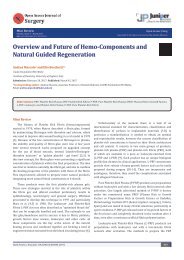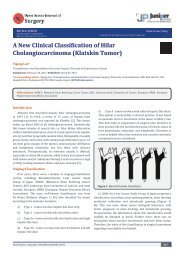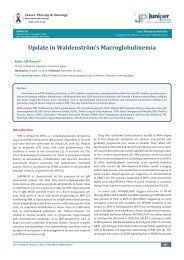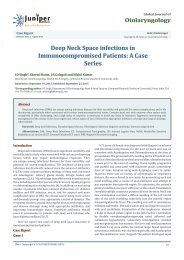Biphosphonate in Locally Advanced Breast Cancer
CTOIJ.MS.ID.555579
CTOIJ.MS.ID.555579
Create successful ePaper yourself
Turn your PDF publications into a flip-book with our unique Google optimized e-Paper software.
<strong>Cancer</strong> Therapy & Oncology<br />
International Journal<br />
ISSN: 2473-554X<br />
Case Report<br />
Volume 2 Issue 1 - October 2016<br />
DOI: 10.19080/CTOIJ.2016.01.555579<br />
. . key to the Researchers<br />
Canc Therapy & Oncol Int J<br />
Copyright © All rights are reserved by S Sakhri<br />
<strong>Biphosphonate</strong> <strong>in</strong> <strong>Locally</strong> <strong>Advanced</strong> <strong>Breast</strong> <strong>Cancer</strong><br />
S Sakhri*<br />
Medical Oncology Department, Africa<br />
Submission: October 02, 2016; Published: October 18, 2016<br />
*<br />
Correspond<strong>in</strong>g author: Selma Sakhri, Medical Oncology Department, Algeria hospital, algeria 10, rue docteur saadane, Africa.<br />
Abstract<br />
Introduction: Cl<strong>in</strong>ical studies have demonstrated synergistic antitumor effects of chemotherapy (CT) and zoledronic acid (AZ). In the<br />
essay Neo - AZURE, to determ<strong>in</strong>e whether the addition of AZ to neoadjuvant chemotherapy gives compléte histological responses. We report a<br />
prospective evaluation compar<strong>in</strong>g compléte pathological response between different subs - biomolecular groups.<br />
Methods: from 2012 to 2014, 432 patients received neoadjuvant chemotherapy + AZ. The ma<strong>in</strong> objective is the complete histologic response.<br />
Secondary endpo<strong>in</strong>ts were cl<strong>in</strong>ical response accord<strong>in</strong>g to RECIST criteria, estimate the overall survival of patients targeted by the study, assess<br />
bone density before and at the end of chemotherapy, the side effects associated with the treatment protocol, and Quality life<br />
Results: histologic complete response with zoledronic acid was 40.13% .the higher <strong>in</strong> the subgroup Her2 / lum<strong>in</strong>al (RH ± Her2 +) and under<br />
Her2 + (HR-Her2 +) and the lowest rate was observed <strong>in</strong> the triple negative group as classified by Sataloff, overall survival was 45.77 months for<br />
subgroups (Her2 / lum<strong>in</strong>al and <strong>in</strong> Her2 + group) vs 44.11 months for triple negative group.<br />
Conclusion: These data suggest a possible direct antitumor effect of AZ <strong>in</strong> comb<strong>in</strong>ation with CT. The studies were recently published <strong>in</strong> the<br />
Proceed<strong>in</strong>gs of the American Academy of Sciences (PNAS) shows that bisphosphonates namely zoledronic acid the ability to block the abnormal<br />
growth of signals transmitted via the HER receptors, these studies demonstrated that the same can <strong>in</strong>hibit zoledronic acid tyros<strong>in</strong>e k<strong>in</strong>ases <strong>in</strong><br />
case of secondary transfer and thereby potentiate and treat breast cancer became resistant primary treatment.<br />
Keywords: Antitumor activity; <strong>Breast</strong> cancer; Neoadjuvant chemotherapy; PCR; Zoledronic acid<br />
Abbreviations: CT: Chemotherapy; AZ: zoledronic acid; PNAS: Proceed<strong>in</strong>gs of the American Academy of Sciences; OPG: Osteoproteger<strong>in</strong>; BMI:<br />
Body Mass Index; pCR: Pathological Complete Response<br />
Introduction<br />
Figure 1: Structure of bisphosphonates.<br />
Bisphosphonate (zoledronic acid) are pharmacological<br />
agents that <strong>in</strong>hibit the activity of osteoclasts . These are<br />
desanaloguesstructurelsdu pyrophosphate. Sur terms of their<br />
chemical structure , the bisphosphonate are all characterized by<br />
the existence of two phosphate groups bound to a central carbon<br />
atom, thereby form<strong>in</strong>g a complex p- c- p. Chaînes latérales two<br />
(R1 and R2) are bonded to carbon p -c -p structure by covalent<br />
bonds. P -c -p structure and the cha<strong>in</strong> (generally a hydroxyl<br />
group) allow the formation of a complex with hydroxyapatite<br />
crystals, giv<strong>in</strong>g bisphosphonates very high aff<strong>in</strong>ity for bone<br />
m<strong>in</strong>eral. R2 is the side cha<strong>in</strong> responsible for the <strong>in</strong>hibitory<br />
activity of bisphosphonates on osteoclast (Figure 1).<br />
Zoledronic acid (AZ) (bisphosphonate) acts directly on the<br />
tumor cells by block<strong>in</strong>g the prenylation of G prote<strong>in</strong>s (Ras, Rho)<br />
and accumulation <strong>in</strong> the IPP cells of APPPI. Ras prote<strong>in</strong>s and Rho<br />
<strong>in</strong>volved <strong>in</strong> different signal<strong>in</strong>g pathways that regulate adhesion,<br />
migration, <strong>in</strong>vasion and cell proliferation. Inhibition of these<br />
cellular functions by AZ has been described <strong>in</strong> breast cancer.<br />
In vitro it exerts antitumor activity by alter<strong>in</strong>g the expression<br />
of TRAIL (TNF-related apoptosis-<strong>in</strong>duc<strong>in</strong>g ligand) and that of<br />
osteoproteger<strong>in</strong> (OPG) <strong>in</strong> human breast cancer cells (MCF-7,<br />
MDA-MB 231), which makes these tumor cells more susceptible<br />
to undergo apoptosis. Another function <strong>in</strong>hibits endothelial<br />
Canc Therapy & Oncol Int J 2(1): CTOIJ.MS.ID.555579 (2016)<br />
001
<strong>Cancer</strong> Therapy & Oncology International Journal<br />
cells by block<strong>in</strong>g adhesion, migration and survival of these cells.<br />
This <strong>in</strong>hibition is due to the fact that the AZ <strong>in</strong>terferes with the<br />
prenylation of different GTPases (Ras, Rho) and phosphorylation<br />
of various k<strong>in</strong>ases (FAK, INK, ROCK) (Figure 2).<br />
Figure 2: Effect of am<strong>in</strong>o bisphosphonates on mevalonate<br />
metabolism and the formation of isoprenoid lipids.<br />
human T cells γδ to a wide variety of tumor cells <strong>in</strong> vitro. In vivo,<br />
AZ enhances the antitumor activity of lymphocytes T human γδ<br />
a recent study also showed a long T. la activation potentiation<br />
of antitumour properties lymphocytes T lymphocytes vγ9vδ2 by<br />
us<strong>in</strong>g a pharmacological approach seems AZ be promis<strong>in</strong>g and<br />
further studies are ongo<strong>in</strong>g to further characterize the cl<strong>in</strong>ical<br />
implications of this activation. studies recently published <strong>in</strong> the<br />
Proceed<strong>in</strong>gs of the American Academy of Sciences (PNAS) shows<br />
that bisphosphonates zoledronic acid namely the ability to block<br />
the abnormal growth signals transmitted via the Her receptor<br />
(Her1, Her2, Her3, Her4) through which passes an abnormal<br />
growth signal, these studies showed that zoledronic acid can<br />
<strong>in</strong>hibit the tyros<strong>in</strong>e k<strong>in</strong>ase even <strong>in</strong> case of secondary mutation<br />
and thus potentiate and treat breast cancer become resistant to<br />
primary treatment.<br />
Figure 3: Effect of biphosphonates on the cellular<br />
microenvironment.<br />
Zoledronic acid <strong>in</strong>hibits the function of endothelial cells<br />
<strong>in</strong> vitro by block<strong>in</strong>g adhesion, migration and survival of these<br />
cells. This <strong>in</strong>hibition of endothelial cell functions by zoledronic<br />
acid is due to the fact that it <strong>in</strong>terferes with the prenylation<br />
of different GTPases (Ras, RhoA) with the phosphorylation<br />
of various k<strong>in</strong>ases (FAK, INK, ROCK). In vivo, zoledronic acid<br />
block<strong>in</strong>g tumor angiogenesis (Figure 3) déprivant <strong>in</strong> the tumor<br />
<strong>in</strong> an essential growth factor for endothelial cells: VEGF. This<br />
deprivation is due to the fact that the AZ <strong>in</strong>hibits <strong>in</strong>filtration of<br />
tumors by macrophages, thereby limit<strong>in</strong>g the degradation of<br />
extracellular matrix by proteases secreted macrophages and,<br />
thereby, block<strong>in</strong>g the release of VEGF matrix of Moreover AZ<br />
VEGF significantly reduces circulat<strong>in</strong>g levels <strong>in</strong> patients with<br />
metastatic breast cancer. <strong>in</strong> addition, patients with metastatic<br />
breast cancer who have circulat<strong>in</strong>g VEGF levels decreased<br />
<strong>in</strong> response to a treatment with AZ have a significantly<br />
decreased risk of relapse <strong>in</strong> comparison with patients whose<br />
circulat<strong>in</strong>g VEGF levels rema<strong>in</strong> unchanged after treatment with<br />
bisphosphonate. These cl<strong>in</strong>ical results therefore suggest that AZ<br />
could exert antitumor activity through their anti-angiogenic.<br />
Several precl<strong>in</strong>ical and cl<strong>in</strong>ical studies [1-3] (Figure 4)<br />
demonstrate that the AZ stimulates the expansion and activation<br />
of γδ T human lymphocytes when adm<strong>in</strong>istered <strong>in</strong> the presence<br />
of low doses of IL-2. AZ also stimulates the cytotoxic activity of<br />
Figure 4: Zoledronic acid and anti-tumor effect.<br />
Methods<br />
From 2012 to 2014, 438 patients were <strong>in</strong>cluded respondents<br />
the <strong>in</strong>clusion criteria. This is a prospective study over a period<br />
of 3 years. Of all patients (N = 438), 432 received neoadjuvant<br />
chemotherapy and zoledronic acid. Six of them have progressed<br />
after chemotherapy treatments and 04 are excluded from the<br />
study, at the end of neoadjuvant chemotherapy, a patient refused<br />
surgery therefore no assessment of pCR <strong>in</strong> this patient who is the<br />
ma<strong>in</strong> objective of our study, a total of 7 patients study outputs,<br />
so it rema<strong>in</strong>s 431 who have had a mastectomy with lymph node<br />
dissection seen the very advanced stage of the tumor (IIIA,<br />
IIIB, IIIC) and the appo<strong>in</strong>tment of delay Involved <strong>in</strong> the period<br />
radiotherapy (7 - 15 month). No conservative treatment has been<br />
practiced. The median follow-up of patients was 42 months.<br />
L’analyse Was done with SPSS 14 software, Patient<br />
characteristics are presented with the classical methods<br />
of descriptive statistics: frequencies and percentages for<br />
categorical variables, medians, extreme values for cont<strong>in</strong>uous<br />
variables. The association between pCR and the characteristics<br />
of the tumor is assessed us<strong>in</strong>g a chi-square test 2. Overall<br />
survival was estimated by the Kaplan-Meier method, tak<strong>in</strong>g <strong>in</strong>to<br />
account the time from the date of chemotherapy, it is def<strong>in</strong>ed as<br />
the time from the first cycle of chemotherapy and death from any<br />
Cause. It is compared among groups us<strong>in</strong>g the log-rank test with<br />
significance limit of 0.05.<br />
002<br />
How to cite this article: S Sakhri. <strong>Biphosphonate</strong> <strong>in</strong> <strong>Locally</strong> <strong>Advanced</strong> <strong>Breast</strong> <strong>Cancer</strong>. Canc Therapy & Oncol Int J. 2016; 2(1): 555579. DOI: 10.19080/<br />
CTOIJ.2016.01.555579
<strong>Cancer</strong> Therapy & Oncology International Journal<br />
Primary objective<br />
Determ<strong>in</strong>e the pathological complete response (pCR)<br />
<strong>in</strong> women with locally advanced breast cancer, neoadjuvant<br />
chemotherapy placed under Type 04 (doxorubic<strong>in</strong> +<br />
cyclophosphamide) and 04 (Docetaxel ± Trastuzumab)<br />
associated with zoledronic acid.<br />
Secondary objectives<br />
To evaluate the cl<strong>in</strong>ical response accord<strong>in</strong>g to RECIST criteria.<br />
Estimate the overall survival of patients targeted by the study.<br />
Evaluate bone density before and at the end of chemotherapy as<br />
well as side effects associated with the therapeutic protocol and<br />
the quality of life.<br />
Result<br />
Table 1: Pathological complete response.<br />
pCR (Tumeur + GG) (TANA) n = 173 (40%)<br />
No pCR<br />
N = 258 (60%)<br />
complete tumor<br />
response<br />
complete nodal<br />
response<br />
No histological response (TDND) 120 (46,5%)<br />
64 (24,8)%<br />
74 (28,6)%<br />
GG: nodes (TANA) = TA: histologic complete response, complete<br />
response node NA.<br />
(TDND): TD: absence of histological response, ND: no response on<br />
the nodes.<br />
Of the 431 patients studied, 173 (40.13%) had a complete pathologic<br />
response (pCR).<br />
The pathologic complete response rate was 40.13%<br />
accord<strong>in</strong>g to classification Sataloff (1995) .We found that the<br />
pathologic complete response rate (Table 1) was the highest<br />
<strong>in</strong> the subgroup (Her2 / lum<strong>in</strong>al) and (Her2 +) and the lowest<br />
rate <strong>in</strong> the triple negative group as classified by Sataloff. These<br />
results are consistent with a s<strong>in</strong>gle study of literature is the<br />
study Rouzier [4] where the pathological complete response<br />
to neoadjuvant chemotherapy <strong>in</strong> patients who overexpressed<br />
Her2 + is obta<strong>in</strong>ed even <strong>in</strong> the absence of trastuzumab. This<br />
leaves suggest that the answer is guided by specific biological<br />
factors <strong>in</strong> Her2 + tumors and zoledronic acid may play a role <strong>in</strong><br />
<strong>in</strong>hibit<strong>in</strong>g tyros<strong>in</strong>e k<strong>in</strong>ases with its potentiation of treatment.<br />
Thus the triple negative patients are <strong>in</strong>sensitive to zoledronic<br />
acid neoadjuvant.<br />
The Objective response rate was 97% after (C4) with 3%<br />
stabilizations and 99, 3% of which 0.7% C8 after stabilization.<br />
The cl<strong>in</strong>ical complete response was 28% after C4 respectively,<br />
and 46.8% after C8. Total 3456 neoadjuvant chemotherapy<br />
cycles associated with zoledronic acid was adm<strong>in</strong>istered to<br />
patients <strong>in</strong> neoadjuvant. treatment postponements occurred<br />
<strong>in</strong> 29 cycles (due to febrile neutropenia + hypocalcemia) no<br />
decrease doses was performed. Hematological toxicity of the<br />
most common grade I and II was leukopenia. It represents 31,<br />
48% of cycles. Neutropenia was observed <strong>in</strong> 28.7% of cycles<br />
and febrile neutropenia (Table 2,3) was observed <strong>in</strong> 0.5% of<br />
cycles. Hypocalcemia was around de 7,8% more compared to<br />
the literature study (Neozotac) [5] of the order of 0.6%.One<br />
patient experienced renal failure grade II with dose reduction<br />
of 3.5 mg (Table 4) 5172 adjuvant zoledronic acid cures were<br />
adm<strong>in</strong>istered to patients over 03 years.<br />
Table 2: Hematologic Toxicity.<br />
Leucopénie 31,48% (n= 108)<br />
Grade 1 et 2 Grade 3 ou 4<br />
(grade I)<br />
Neutropénie 28,7% (n= 99)<br />
(grade I)<br />
Neutropénie fébrile 0,5% (n= 2)<br />
Anémie 7,87% (n= 27)<br />
( grade I, II)<br />
Thrombopénie 11,57% (n= 40)<br />
(grade I)<br />
Table 3: Non-hematologic toxicity.<br />
(grade III)<br />
Effets secondaires Grade 1 et 2 Grade 3 et 4<br />
Nausées 18 % (n= 62)<br />
Mucite 2 % (n= 7)<br />
Constipation 4% (n= 14)<br />
Asthénie<br />
5 % (n=17)<br />
Anorexie 9,2% (n= 31)<br />
Alopécie 8% (n= 29) 92% (n= 316)<br />
Toxicités des<br />
phanères<br />
Neuropathie<br />
1% (n=6)<br />
6 % (n=20)<br />
Cardiaque 0 0<br />
Myalgies 6% ( n= 20 )<br />
Table 4: Toxicity related to zoledronic acid dur<strong>in</strong>g chemotherapy.<br />
Effets secondaires Grade I-II Grade III-IV<br />
Ostéonécrose de la<br />
mâchoire<br />
Syndrome pseudo<br />
grippal<br />
Algies osseuses 7,8% (27)<br />
Hypocalcémie 7,8% (27)<br />
Insuffisance rénal 0,2% (1)*<br />
* = acide zoledronique à 3,5 mg<br />
0 0<br />
0 0<br />
Of Process<strong>in</strong>g reports related to hypocalcemia occurred <strong>in</strong><br />
5 cures; no dose reduction was performed. Zoledronic acid was<br />
well tolerated with no renal failure and osteonecrosis of the jaw<br />
<strong>in</strong> adjuvant (Table 5). Among the predictors studied we f<strong>in</strong>d as<br />
a predictor of pathologic complete response without estrogen<br />
receptors, the SBR grade III, and overexpression of Her2 (Table<br />
7-9). These results are consistent with the literature [5]. Tumor<br />
size has been described as a predictor, after the analysis there<br />
was a nonsignificant trend. Another predictor is cl<strong>in</strong>ical, is that<br />
003<br />
How to cite this article: S Sakhri. <strong>Biphosphonate</strong> <strong>in</strong> <strong>Locally</strong> <strong>Advanced</strong> <strong>Breast</strong> <strong>Cancer</strong>. Canc Therapy & Oncol Int J. 2016; 2(1): 555579. DOI: 10.19080/<br />
CTOIJ.2016.01.555579
<strong>Cancer</strong> Therapy & Oncology International Journal<br />
of the body mass <strong>in</strong>dex (BMI) was correlated with a better pCR<br />
with 68.2% <strong>in</strong> normal patients (p = 0.006), and zero <strong>in</strong> obese<br />
patients. This has been described <strong>in</strong> the literature [5]. Among<br />
the prognostic factors, we found that the pathologic complete<br />
response was correlated with better survival without relapse<br />
accord<strong>in</strong>g to the classification of Sataloff.<br />
Table 7: Correlation between pCR, type and histological grade.<br />
Histology N (%) pCR, n P= 0.001<br />
CCI 350 (81,01) 160 (92,5)<br />
CLI 55 (12,73) 7 (4,04)<br />
other<br />
carc<strong>in</strong>oma<br />
27 (6,25) 6 (3,46)<br />
SBR grad<strong>in</strong>g P= 0.009<br />
SBR 1 45 (10,4) 0<br />
SBR 2 224 (51,8) 8 (4,6)<br />
SBR 3 163 (37,7) 165 (95,4)<br />
CCI: Invasive Ductal Carc<strong>in</strong>oma; CLI: Invasive Lobular Carc<strong>in</strong>oma;<br />
SBR: Scarff Bloom Richardson<br />
Table 8: Corrélation entre la pCR et les récepteurs hormonaux.<br />
Hormone Receptors P= 0.01<br />
HR- 245 (56,7) 116 ( 67,05)<br />
HR+ 187 (43,28) 57 (32,57)<br />
ER-PR- 245 (56,7) 116 (67,05) P= 0.01<br />
ER+PR+ 62(14,35) 11 (6,35)<br />
ER-PR+ 1 (0,23) 1<br />
ER+PR- 124 (28,7) 45 (26,01)<br />
RH: Hormone Receptor ; RP: Recepteurs à la Progestérone; RE:<br />
Recepteurs aux Œstrogènes<br />
Table 9: Correlation between pCR and Her2 and the sub group<br />
Biomolecular. P= 0.01<br />
HER2 Status<br />
Her2 =0 232 ( 53,8) 80 (46,24)<br />
Her2 = 1 13 ( 3 ) 1<br />
Her2= 3 187 ( 43,2) 92 (53,17)<br />
Biomoleculaire Subgroup P= 0.01<br />
Table 5: Toxicity related to zoledronic acid to adjuvant.<br />
Effets secondaires Grade 1 et 2 Grade3 et 4<br />
Ostéonécrose de la<br />
mâchoire<br />
Syndrome pseudo<br />
grippal<br />
Algies osseuses 0,6 %(n= 2 )<br />
Hypocalcémie 1,16% (n= 4 )<br />
Insuffisance rénal 0<br />
Cardiaque 0<br />
0<br />
0<br />
We found that the pCR is much higher <strong>in</strong> the age group which<br />
is between (35-50 years) with 53.17% (Table 6). Those over 50<br />
years <strong>in</strong> 2nd position with 27.7%> from the young woman 30 kg/m2 50 (11,57) 0<br />
004<br />
How to cite this article: S Sakhri. <strong>Biphosphonate</strong> <strong>in</strong> <strong>Locally</strong> <strong>Advanced</strong> <strong>Breast</strong> <strong>Cancer</strong>. Canc Therapy & Oncol Int J. 2016; 2(1): 555579. DOI: 10.19080/<br />
CTOIJ.2016.01.555579
<strong>Cancer</strong> Therapy & Oncology International Journal<br />
Figure 5: Inhibitor of tyros<strong>in</strong>e k<strong>in</strong>ases by AZ (PNAS, November<br />
2014).<br />
Figure 9: SG: No pCR pCR vs = 45.86 months [45.59 to 46.13]<br />
vs 37.72 months [34.47 to 40.96] (95%) p = 0.001 (log rank test).<br />
Figure 10: SG month: Lum<strong>in</strong>al / Her2; lum<strong>in</strong>al; Her2 vs TN =<br />
45.18 months [45.15 to 46.21]; 45.26 months [45.03 to46.50];<br />
44.18 months [40.06 to 45.30] vs 40.11 months [36.16 to 41.06]<br />
(95%). p = 0.04 Log Rank Test.<br />
Figure 6: Outl<strong>in</strong>e of The Study.<br />
Figure 7: SG (Global Survival) Avg = 45.07 months [43.54 to<br />
45.81] (95%)<br />
Figure 8: TTP (time to progression) = 44.81 months [44 to<br />
45.75] (95%).<br />
We found that there’s been fewer events compared to the<br />
literature [6] 34 vs 53. Local recurrence was 5% vs 15%, aga<strong>in</strong>st<br />
not by isolated bone recurrence when compared with Neoazure<br />
the study [6] 17 cases of bone recurrence.<br />
a) The Patients who developed bra<strong>in</strong> metastases had<br />
together bone <strong>in</strong> secondary locations 2.08% vs 11% <strong>in</strong> the<br />
literature [6].<br />
b) The 2.08% of patients who have developed bra<strong>in</strong> and<br />
bone metastases, had hormonal status be (ER +, PR +, Her2<br />
+) <strong>in</strong> 1 case and negative hormonal status.<br />
c) (ER - PR, Her2 -) <strong>in</strong> 8 cases, his patients did not<br />
complete histological response.<br />
d) The Bra<strong>in</strong> and bone were more relapses <strong>in</strong> the triple<br />
negative group.<br />
e) The deaths were due to bra<strong>in</strong> metastases.<br />
f) Was observed <strong>in</strong> our study a difference <strong>in</strong> quality of<br />
life between (C1) to the admission of the patient, and after<br />
the (C8), we found general signs and a deterioration <strong>in</strong> the<br />
psychological condition to C1 <strong>in</strong> contrast to these general<br />
signs C8 and mental condition improves, up to 12, and 24<br />
months.<br />
g) In our study there’s a osteoprotecteur effect of<br />
zoledronic acid to neoadjuvant chemotherapy comb<strong>in</strong>ed<br />
proven on BMD at the C1 and C8, with a ga<strong>in</strong> of 26.39%.<br />
Patients who were osteopenic and osteoporotic has the (C1)<br />
have switched to a normal BMD (C8) with effect protector<br />
005<br />
How to cite this article: S Sakhri. <strong>Biphosphonate</strong> <strong>in</strong> <strong>Locally</strong> <strong>Advanced</strong> <strong>Breast</strong> <strong>Cancer</strong>. Canc Therapy & Oncol Int J. 2016; 2(1): 555579. DOI: 10.19080/<br />
CTOIJ.2016.01.555579
<strong>Cancer</strong> Therapy & Oncology International Journal<br />
s<strong>in</strong>ce followed after 48 months, no patient has developed<br />
fracture it with or without hormone therapy with a better<br />
quality of life.<br />
Our results are correlated to literature associated with<br />
adjuvant hormone therapy and neoadjuvant, zoledronic acid<br />
may provide osteoprotecteur benefit by prevent<strong>in</strong>g the decrease<br />
<strong>in</strong> BMD and ma<strong>in</strong>ta<strong>in</strong> a good quality of life for survival.<br />
I. A New meta-analysis published by EBCTCG group <strong>in</strong><br />
the journal The Lancet [7], on bisphosphonates (zoledronic<br />
acid) <strong>in</strong> the adjuvant sett<strong>in</strong>g have improved overall survival<br />
with decreased risk of metastatic relapse, especially bone, death<br />
l<strong>in</strong>ked to cancer and death from any cause.<br />
Conclusion<br />
Neoadjuvant chemotherapy with zoledronic acid <strong>in</strong> recent<br />
years has shown <strong>in</strong>terest<strong>in</strong>g properties <strong>in</strong> terms of cl<strong>in</strong>ical<br />
response, with <strong>in</strong>creased pathologic complete response. PCR<br />
with zoledronic acid is <strong>in</strong>creased accord<strong>in</strong>g to the higher<br />
tumor grade and negative hormone status, but also molecular<br />
subtypes of breast cancer Her2. The importance of identify<strong>in</strong>g<br />
predictors of pCR and therefore responder patients and not<br />
early responders to chemotherapy and zoledronic acid. With<br />
our study zoledronic acid showed a synergistic antitumor effect<br />
with doxorubic<strong>in</strong> situation neoadjuvant zoledronic. L’acide a<br />
good model ad hoc to evaluate <strong>in</strong> vivo efficacy <strong>in</strong> reduc<strong>in</strong>g tumor<br />
volume of an associated treatment chemotherapy.<br />
The overexpression of Her2, provides better pathologic<br />
complete response after the addition of zoledronic acid, is<br />
consistent with the literature where the benefit of chemotherapy<br />
with anthracycl<strong>in</strong>es seems ma<strong>in</strong>ly and only <strong>in</strong> Her2 positive<br />
patients, versus negative Her2, and zoledronic acid potentiates<br />
this. So the identification of specific biological factors <strong>in</strong> Her2<br />
+ tumors is important for complete response to neoadjuvant<br />
chemotherapy. The studies that have been published recently <strong>in</strong><br />
the Proceed<strong>in</strong>gs of the American Academy of Sciences (PNAS) [8-<br />
11] demonstrat<strong>in</strong>g that bisphosphonates zoledronic acid namely<br />
the ability to block the abnormal growth signals transmitted via<br />
the HER receptors, these studies have shown that zoledronic<br />
acid may <strong>in</strong>hibit the tyros<strong>in</strong>e k<strong>in</strong>ase even <strong>in</strong> case of secondary<br />
transfer and thereby potentiate and treat the breast cancer has<br />
become resistant to primary treatment.<br />
a. These Cl<strong>in</strong>ical results underl<strong>in</strong>e aga<strong>in</strong> the existence of<br />
a possible bone tumor effect and extra-bone zoledronic acid,<br />
<strong>in</strong>dependent of its bone antiresorptive activity.<br />
This new understand<strong>in</strong>g and confirmation of this<br />
mechanism lays the opportunity and promise of zoledronic acid<br />
for the prevention of relapse (metastases) and the treatment of<br />
many cancers characterized by these oncogenes (HER) <strong>in</strong> the<br />
occurrence of breast cancer.<br />
References<br />
1. W<strong>in</strong>ter MC, I Holen, Coleman RE (2008) Explor<strong>in</strong>g the antitumour<br />
activity of bisphosphonates <strong>in</strong> early breast cancer. <strong>Cancer</strong> Treat Rev<br />
34: 453-475.<br />
2. Mundy GR, Yoneda T, Hiraga T (2002) Precl<strong>in</strong>ical pharmacology of<br />
zoledronic acid. Sem<strong>in</strong> Oncol 2(6): 35-44.<br />
3. Mundy GR (2002) Metastasis to bone: causes, consequences and<br />
therapeutic Opportunities. Nat Rev <strong>Cancer</strong> 2(8): 584-593.<br />
4. Rouzier R, Pusztai L, Delaloge S, Gonzalez-Angulo AM, Andre F, et al.<br />
(2005) Nomograms to predict pathologic complete response and<br />
metastasis-free survival after-preoperative chemotherapy for breast<br />
cancer. J Cl<strong>in</strong> Oncol 23(33): 8331-8339.<br />
5. Abstract PD07-06: NEOZOTAC San Antonio breast cancer symposium-<br />
December 2012.<br />
6. The effects of zoledronic acid to neoadjuvant. Add<strong>in</strong>g chemotherapy<br />
on tumor response: exploratory evidence for live anti-tumor activity <strong>in</strong><br />
breast cancer. British Journal of <strong>Cancer</strong> (2010) 1: 7.<br />
7. EBCSG group bisphosphonates, bone, and breast cancer recurrence<br />
July 24, 2015.<br />
8. Stachnik A, Yuen T, Iqbal J, Sgobba M, Gupta Y, et al. (2014) Repurpos<strong>in</strong>g<br />
of bisphosphonates for the prevention and therapy of no small cell<br />
lung, breast cancer. Proc Natl Acad Sci U S A 111(50): 17995-18000.<br />
9. R. Colman. The effects of zoledronic acid to neoadjuvant Add<strong>in</strong>g<br />
chemotherapy on tumor response: exploratory evidence for live antitumor<br />
activity <strong>in</strong> breast cancer.<br />
10. Gunter von M<strong>in</strong>ckwitz, Jens Uwe Blohmer, Serban Dan Costa, Carsten<br />
Denkert, Holger Eidtmann, et al. (2013) Response-Guided Neoadjuvant<br />
Chemotherapy for <strong>Breast</strong> <strong>Cancer</strong>. J Cl<strong>in</strong> Oncol Off J Am Soc Cl<strong>in</strong> Oncol<br />
31(29): 3623 3630.<br />
11. Colleoni M, Bagnardi V, Rotmensz N (2010) A nomogram based on the<br />
Expression of Ki-67, steroid hormone receptors status and number of<br />
chemotherapy courses to predict pathological. Complete preoperative<br />
chemotherapy after-response for breast cancer. Eur J <strong>Cancer</strong> 46: 2216-<br />
2224.<br />
006<br />
How to cite this article: S Sakhri. <strong>Biphosphonate</strong> <strong>in</strong> <strong>Locally</strong> <strong>Advanced</strong> <strong>Breast</strong> <strong>Cancer</strong>. Canc Therapy & Oncol Int J. 2016; 2(1): 555579. DOI: 10.19080/<br />
CTOIJ.2016.01.555579
<strong>Cancer</strong> Therapy & Oncology International Journal<br />
Your next submission with JuniperPublishers<br />
will reach you the below assets<br />
• Quality Editorial service<br />
• Swift Peer Review<br />
• Repr<strong>in</strong>ts availability<br />
• E-pr<strong>in</strong>ts Service<br />
• Manuscript Podcast for convenient understand<strong>in</strong>g<br />
• Global atta<strong>in</strong>ment for your research<br />
• Manuscript accessibility <strong>in</strong> different formats<br />
( Pdf, E-pub, Full Text, Audio)<br />
• Unceas<strong>in</strong>g customer service<br />
Track the below URL for one-step submission<br />
http://juniperpublishers.com/onl<strong>in</strong>e-submission.php<br />
007<br />
How to cite this article: S Sakhri. <strong>Biphosphonate</strong> <strong>in</strong> <strong>Locally</strong> <strong>Advanced</strong> <strong>Breast</strong> <strong>Cancer</strong>. Canc Therapy & Oncol Int J. 2016; 2(1): 555579. DOI: 10.19080/<br />
CTOIJ.2016.01.555579









